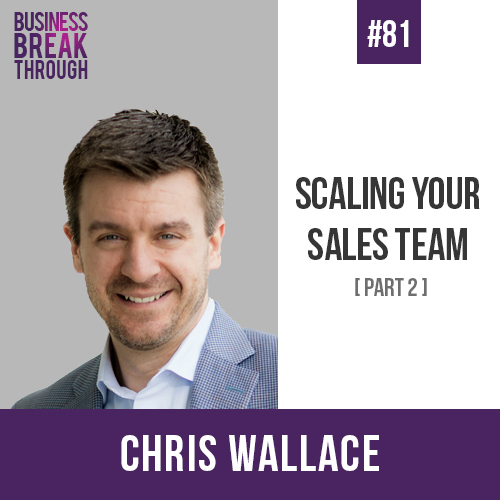81: Scaling your Sales Team with Chris Wallace (Part 2)

Ever heard the phrase “accidental entrepreneur”? That’s exactly what Chris Wallace is. He always planned to follow the corporate route, but after getting his MBA and finding a job in the corporate space, Chris realized that he would make a ton more money filling the exact same role, but as an entrepreneur with his own company.
In this episode, Chris shares with us the key to ensure that your brand is consistently displayed across your business, which he’s figured out from his unique experience as both a business-owner-boss and a down-in-the-trenches-employee. If you want to make sure that your front line employees are giving over the same message as your billboards and email campaigns, this episode is a must-listen!
My Guest: Chris Wallace
Chris is the president and co-founder of Inner View group, his third business and his most fun one yet. After selling his sales consulting coaching business inside sales, Chris built his second company, Growth Play, until he was presented with the chance to walk away and start from scratch. Inner View Group is the culmination of everything they’ve learned over the years, including the mistakes!
Chris has a passion for taking the ideas and strategies that come from the corporate tower and helping companies bring them to life through the frontline employees and ultimately, their customers. Chris and his team help make sure that no good idea goes wasted.
Chris is also an author and a teacher, has been published in outlets from Harvard Business Review, Marketing Insider, Total Retail and a whole bunch more. He also worked as an adjunct professor at Temple Fox School of Business MBA program.
Episode Highlights:
04:49: The average corporate initiative reaches somewhere between 60 and 70% of its target objective, and typically that’s measured in revenue. So we look at that and say, it’s really not an issue of strategy, it’s an issue of execution.
10:52: Estie:So when people get cable TV, what they see, depending on where they subscribe, depends on guys like you getting it to their parent providers.
Chris: That’s correct. Think of it as a wholesaler relationship, but rather than wholesaling widgets or something tangible, you’re wholesaling cable TV channels.
14:39: Diana was a colleague of mine from when I worked in the entertainment business. She had just had a year maternity leave and wanted to get back in the workforce. And I said I’m desperate for help. And she said I’m desperate to get out of the house. And we that’s when we partnered up.
21:09: We merged Inside Sales with a firm out of Chicago called Growth Play. We were not the first entrepreneurs to sell or merge our company with somebody else. And, you know, sometimes it doesn’t work. The moment that Diana and I looked at each other and realized it was not going to be a long term place for us, it was sobering and disappointing.
25:38: And one of the things that I found, and this is an advantage that I think you and I both have, most entrepreneurs were never employees. I was an employee for over a decade before I went out of my own. And for an entrepreneur that’s never been an employee:
- They don’t really understand employees
- They don’t understand the employee mindset
- What it means to take orders
- What it means to need orders
31:39: You can get somebody to know something, but knowledge doesn’t force people to act. Belief causes people to act. And marketers are out there trying to build belief with their customers, but they’re not building belief with the people that talk to their customers.
35:50: I just looked at the client and I said, “You are literally having the main person who’s supposed to help get you clients who doesn’t even believe that the thing you do works at all.”
43:57: The person who stands in front of the customer, or is on the other end of the phone, they are the face of the brand. It’s not a billboard, it’s not an ad, it’s not a digital banner, but that person really is the face of the brand. You’ve got 100 product managers, and you’ve got a million VP and you’ve got all these different people back at corporate, but the success or failure of what the customer thinks of your brand hinges on that one person in that one moment.
48:30: Most businesses are not in a spot where they can put all the money they want into developing their current clients and delivering the best in class that they possibly can, and also spend as much money as they want and need to acquire new clients at the rate they want to. So there’s always tension between investment and servicing what I have, and investment in trying to gain new clients.
53:37: Turn your business into an ATM. For every dollar you spend on marketing, which by me includes sales as well, it should pay you back $10.
Quote:
Nobody likes to be sold but they love to buy.
Resources & Links:
- Find Chris: innerviewgroup.com
- Find Chris on Social: LinkedIn
- Work with Estie: www.strandconsulting.net
- Join us on the Show: www.estierand.com/breakthrough
For Part 2 of this episode, where you can hear more business advice from Chris, go to estierand.com/81-1.
Did you enjoy this episode? Then subscribe to my podcast on iTunes, so you can get automatic updates whenever another episode goes live (and you will be helping me get to #1 on iTunes, making us all cooler in the process!)

